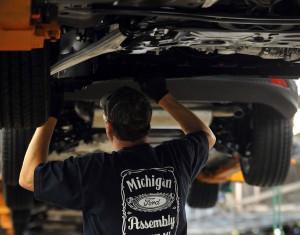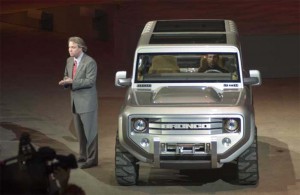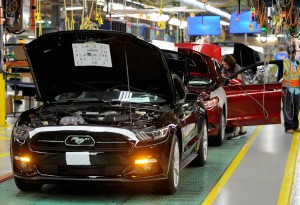Ford Motor Co. will invest $1.2 billion in three Michigan facilities, the automaker announced Tuesday, a move signaled overnight through a tweet from Pres. Donald Trump.
The three projects the package covers will help save and, in some cases add, thousands of jobs in the suburban Detroit region, in line with one of the president’s priorities. But a senior executive from Ford told TheDetroitBureau.com that all three projects were in the works well before Trump took office – the largest, involving an $850 million assembly plant investment, approved as part of a deal with the United Auto Workers Union in 2015.
The announcement is “consistent with what we announced previously,” said Joe Hinrichs, Ford’s President of the Americas, though he quickly stressed that Ford is “encouraged by the pro-growth approach the administration is trying to follow. We continue to be encouraged by the dialogue.”
The three investments are all part of a package that Ford is presenting to the state of Michigan today, the automaker seeking about $30 million in tax abatements and other savings over the next 15 years.
The largest project will see $850 million go into the Michigan Assembly Plant, in Wayne, about 15 minutes west of the automaker’s headquarters in the Detroit suburbs. The factory had been producing a mix of small cars, including the Ford Focus, which will now be moved to a plant in Mexico.
That decision triggered the rage of then-candidate Donald Trump, who warned that he would enact a border tax to penalize Ford. But the move was actually being made so that the automaker could utilize the Wayne plant to produce two new truck models – modern reincarnations of Ford’s old Bronco SUV and Ranger pickup. In today’s truck-centered U.S. model, analysts say, that strategy is far more likely to retain and even grow jobs.
(Ford confirms return of Bronco and Ranger. Click Here for the full story.)
The decision to put the Ranger and Bronco into the Michigan Assembly Plant was actually locked into place in the four-year contract that Ford signed with the United Auto Workers Union in late 2015. The one major development is that Ford has decided to increase its investment in the factory from $700 million to $850 million, which appears to reflect optimism for the sales prospects for the two vehicles.
Hinrichs would not discuss what the added investment might mean on a jobs front, but Ford previously said it plans to retain the more than 3,200 workers who had been employed on that assembly line.
(Ford Q1 earnings to take a big hit. Click Here for the full story.)
To supply powertrains for those two new trucks, as well as other, existing models, Ford says it will invest $150 million in its Romeo Engine Plant in the northern Detroit suburbs. That move is expected to “create or retain 130 jobs,” according to a statement issued by the automaker.
The third investment will see Ford spend $200 million to build an all-new data center alongside its assembly plant in the southern Detroit suburb of Flat Rock, Michigan.
“The data center is about where the future is going with connected vehicles,” explained Ford Pres. Hinrichs.
The second-largest domestic automaker has repositioned itself as a “mobility company,” focusing on more than just car manufacturing. It is backing that up with investments in such things as autonomous and self-driving vehicles, as well as in-car data services. Just last week, Starbucks announced a three-way project with Amazon and Ford that will let owners of vehicles with the automaker’s latest Sync3 infotainment system order coffee with the touch of a button on their steering wheels.
The Flat Rock data center will support a similar facility going into Ford’s headquarters complex which, itself, is in the midst of a multi-billion-dollar renovation announced last year. Hinrichs said it is too early to say how many white-collar jobs will be created, but the number is expected to be significantly smaller than what is being announced at the Wayne Assembly Plant.
Since the beginning of the year, Ford has announced about $1.9 billion in new U.S. investments. With one exception, all those moves date back to well before the election of 2016, noted Hinrichs. The one exception was the decision to start producing electrified vehicles at the Flat Rock Assembly Plant. That was locked into place in December. Several other U.S. factories were under consideration for that project.
Ford had originally planned to detail its $1.2 billion investment package on Tuesday morning, ahead of its meeting with Michigan officials. Instead, Pres. Trump signaled the announcement with one of his overnight tweets.
He has made it a priority for his administration to deliver new jobs, especially in manufacturing. That was a subject he highlighted during a meeting with the CEOs of Detroit’s Big Three automakers shortly after taking office. Trump raised the issue of U.S. investments again during a visit to suburban Detroit earlier this month that also brought out senior officials of numerous foreign-owned automakers, including Jim Lentz, the CEO of Toyota’s U.S. operations.
But observers caution that the president has been taking claim for moves that were in the works well ahead of his election. That includes Ford’s decision to cancel plans for a second Mexican assembly plant – which Hinrichs previously told TheDetroitBureau.com was the result of declining demand for small cars.
Last week, the president also boasted about an announcement by Charter Communications to bring 15,000 customer service workers back to the U.S., a project the company actually had put in place well before the 2016 election.
(GM laying off 1,000 workers. Click Here for the story.)



